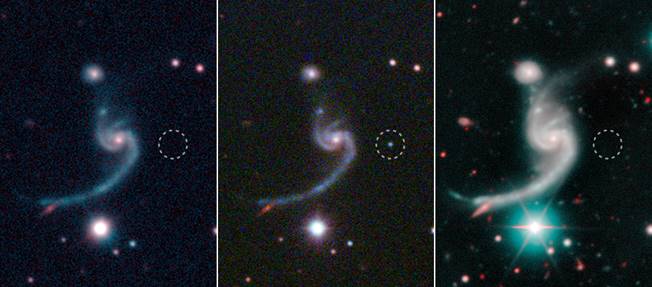Dying Star Robbed of Its Stellar Mass by Covert Companion

A covert companion siphoned material from its stellar neighbor before that star exploded in a fiery death, a new study suggests.
When a massive star runs out of fuel, it collapses inward on itself, creating a bright explosion known as a supernova. As a result, the stellar material from the outer layers of the dying star is ejected into space, leaving behind a dense neutron star. Generally, this material is the equivalent of a few times the mass of the sun.
However, observations of a fairly faint supernova called iPTF 14gqr that occurred on the outskirts of a spiral galaxy located 920 million light-years away show that this stellar explosion faded quickly. It expelled material only one-fifth of the mass of the sun, according to a statement. [Supernova Photos: Great Images of Star Explosions]
"We saw this massive star's core collapse, but we saw remarkably little mass ejected," Mansi Kasliwal, assistant professor of astronomy at Caltech, said in the statement. "We call this an ultrastripped envelope supernova, and it has long been predicted that they exist. This is the first time we have convincingly seen core collapse of a massive star that is so devoid of matter."
In order for a star to explode as a supernova, it has to have enough mass. This indicates that iPTF 14gqr was previously enveloped in lots of material, according to the statement.
Observations from the Palomar Observatory in Southern California suggest that the neutron star has a hidden companion that stripped the star of its mass before it exploded. This would explain the dying star's missing mass, the researchers said.
Get the Space.com Newsletter
Breaking space news, the latest updates on rocket launches, skywatching events and more!
What's more, the thieving stellar companion — possibly a white dwarf, neutron star or black hole — would have to be close enough to the dying neutron star to gravitationally siphon away its mass before it exploded. Therefore, the neutron star and its companion are believed to be part of a compact neutron-star binary system, according to the statement.
Using the Intermediate Palomar Transient Factory (iPTF) at Palomar Observatory, astronomers were able to observe the supernova in the very first hours after it exploded.
"You need fast transient surveys and a well-coordinated network of astronomers worldwide to really capture the early phase of a supernova," Kishalay De, lead author and graduate student at Caltech, said in the statement. "Without data in its infancy, we could not have concluded that the explosion must have originated in the collapsing core of a massive star with an envelope about 500 times the radius of the sun."
The dead neutron star and its companion are expected to eventually merge. Using the Zwicky Transient Facility — the successor of iPTF at Palomar Observatory — astronomers hope to capture more of these rare supernova events, according to the statement.
The findings will be published Oct. 12 in the journal Science.
Follow Samantha Mathewson @Sam_Ashley13. Follow us @Spacedotcom, Facebook and Google+. Original article on Space.com.
Join our Space Forums to keep talking space on the latest missions, night sky and more! And if you have a news tip, correction or comment, let us know at: community@space.com.

Samantha Mathewson joined Space.com as an intern in the summer of 2016. She received a B.A. in Journalism and Environmental Science at the University of New Haven, in Connecticut. Previously, her work has been published in Nature World News. When not writing or reading about science, Samantha enjoys traveling to new places and taking photos! You can follow her on Twitter @Sam_Ashley13.









